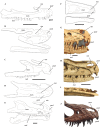Halszkaraptor escuilliei and the evolution of the paravian bauplan
- PMID: 31712644
- PMCID: PMC6848195
- DOI: 10.1038/s41598-019-52867-2
Halszkaraptor escuilliei and the evolution of the paravian bauplan
Erratum in
-
Author Correction: Halszkaraptor escuilliei and the evolution of the paravian bauplan.Sci Rep. 2020 Feb 19;10(1):3333. doi: 10.1038/s41598-020-60007-4. Sci Rep. 2020. PMID: 32071387 Free PMC article.
Abstract
The evolution of birds from dinosaurs is a subject that has received great attention among vertebrate paleontologists. Nevertheless, the early evolution of the paravians, the group that contains birds and their closest non-avian dinosaur relatives, remains very poorly known. Even the most basal members of one paravian lineage, the Dromaeosauridae, already show a body plan that differs substantially from their closest non-paravian relatives. Recently, the dromaeosaurid Halszkaraptor escuilliei was described from the Cretaceous of Mongolia. Halszkaraptor possesses numerous unserrated premaxillary teeth, a platyrostral rostrum with a developed neurovascular system, an elongate neck, bizarrely-proportioned forearms, and a foreword-shifted center of mass, differing markedly from other paravians. A reevaluation of the anatomy, taphonomy, environmental setting, and phylogenetic position of H. escuilliei based on additional comparisons with other maniraptorans suggests that, rather than indicating it was a semiaquatic piscivore, the body plan of this dinosaur bears features widely distributed among maniraptorans and in some cases intermediate between the conditions in dromaeosaurids and related clades. I find no evidence for a semiaquatic lifestyle in Halszkaraptor. A phylogenetic reevaluation of Halszkaraptorinae places it as the sister clade to Unenlagiinae, indicating the bizarre features of unenlagiines previously interpreted as evidence of piscivory may also represent a mosaic of plesiomorphic, derived, and intermediate features. The anatomy of Halszkaraptor reveals that dromaeosaurids still possessed many features found in more basal maniraptoran and coelurosaur clades, including some that may have been tied to herbivory. Rather than being a semiaquatic piscavore, Halszkaraptor was a basal dromaeosaurid showing transitional features.
Conflict of interest statement
I declare that the authors have no competing interests as defined by Nature Research, or other interests that might be perceived to influence the results and/or discussion reported in this paper.
Figures






References
-
- Gauthier J. Saurischian monophyly and the origin of birds. Mem. Cal. Acad. Sci. 1986;8:1–55.
-
- Zanno LE. A taxonomic and phylogenetic re-evaluation of Therizinosauria. J. Syst. Palaeo. 2010;8:503–543. doi: 10.1080/14772019.2010.488045. - DOI
-
- Zanno LE. Osteology of Falcarius utahensis: characterizing the anatomy of basal therizinosaurs. Zool. J. Linn. Soc. 2010;158:196–230. doi: 10.1111/j.1096-3642.2009.00464.x. - DOI
-
- Makovicky, P. J., Kobayashi, Y. & Currie, P. J. Ornithomimosauria. In: Weishampel, D. B., Dodson, P. & Osmólska, H. eds The Dinosauria (Second Edition). Berkeley: University of California Press. pp. 137–150 (2004).
MeSH terms
LinkOut - more resources
Full Text Sources

